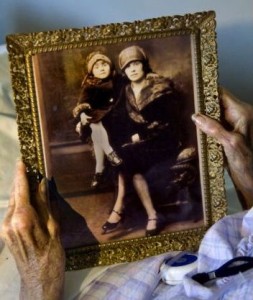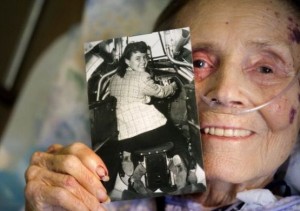The framed sepia photograph flashes a dazzling flapper draped in fur and Pat White as a child posing in a tailored coat to match her mother’s.
“That’s me at 4 years old in my first fur coat,” Pat said.
I detected a confident gusto in this dying woman swaddled in a hospital bed in a board and care room in Mission Viejo.
“We never felt the Depression,” Pat, 89, said with a chuckle.
Congestive heart failure affects her breathing but not her mind or spirit. I knew we were in for a captivating life review video, the brainchild of Donna Miller, director of volunteer services of Hospice Care of the West.
Since researching my book “Parting Ways,” I’ve been following Donna as she guides hospice patients on a tour of their past, triggered by a list of interview questions.
It’s a raw last conversation. We’ve heard many life stories, war accounts, prisoner of war nightmares and confessions that folks share before going to the grave. Yet, I’ve never been vividly transported to the underworld of Prohibition.
Donna set up the video camera and started with Pat’s birth in Percy, Ill. Pat’s birth name was Mary Helen Keller. She was nicknamed Patsy. Her mother said that she had to leave Pat’s father nine months after the birth.
Carl Shelton, leader of the Shelton Gang, was the first in a string of stepfathers, Pat said. That’s when the room ebbed as we traveled back to Pat’s childhood. She recalled her early life with the Shelton brothers, who ran East St. Louis and Southern Illinois the way Al Capone ran Chicago.
“I grew up in an affluent family,” she said. “The money just rolled in. We just kept living high.”
“What did your family do?” Donna asked.
“Well, the Sheltons were running Southern Illinois, all the gambling places, card lounges and restaurants,” she said. “Everybody who had slot machines paid to them. There was never any crime. They controlled better than the police.”
She described her mother, born Helen Niemeyer, as a Roaring ’20s bombshell, a gangster’s wife.
“My mother commanded the room,” Pat said.
“How did your mother influence you?” Donna asked.
“Very strongly, with the fact that I was as good as any man; she gave me attitude,” Pat said. “I could have anything or be anything I wanted.”
Pat’s mother dressed her like a doll in georgette dresses and took her out in the evenings for dinner with adults.
“I never had any childhood friends. I wasn’t encouraged to make friends outside of the family.”
“Do you know why that was?” Donna asked.
“I was always told we don’t talk about family, unless we’re with family,” she said. “This is the first time I’ve opened my mouth.”
She lived in a protective bubble away from the eyes of the Sheltons’ rivals. As a child, Pat had a bodyguard named “Eli” who packed a revolver.
“When we were in town, I could always see him out of the corner of my eye or over my shoulder,” she said.
Though they moved often, some of her fondest memories are of riding her horse “Toby” on the farm with Uncle Bernie, which is a very different side of the gangster known as the guy who did Carl’s dirty work.
I later learned when sifting through newspaper archives that the Sheltons made their fortune bootlegging. The Saturday Evening Post called the Shelton brothers “America’s Bloodiest Gang” for the gang wars that occurred in Herrin, a town just south of Percy, and later, Peoria.
I also exchanged emails with Taylor Pensoneau, author of “Brothers Notorious: The Sheltons.” Carl was widely recognized as “handsome, charming and a ladies’ man.” He had multiple marriages and mistresses. Pensoneau also mentioned, “Bernard (Bernie) Shelton loved horses and always had a stable full of them.”

Pat Keller, 4, (now White) with her mom, Helen, in a 1925 picture with both wearing fur coats. Pat grew up in the Shelton Gang, who ran gambling, saloons and bootlegging businesses. CINDY YAMANAKA, THE ORANGE COUNTY REGISTER
Pat earned her chops as the daughter of a gangster family. Her uncles trained her how to shoot guns. She became a streetwise, tough dame like her mother.
As she matured, Pat realized the family’s code of silence was an armor of protection. Her mother decided to move Pat to California because she didn’t want her daughter to be tied with the Sheltons, who were later gunned down by a rival gang.
Pat recalls living among Hollywood’s stars in Brentwood when they first came to California before moving to Belmont Shore in Long Beach. Her after-school activities when attending Long Beach Poly Tech took us on another jaunt into local organized crime history.
She recalls that her new stepdad and uncle bought a ship, anchored it three miles offshore just outside of the government jurisdiction, and turned it into a casino. Pat would drop her books off at home after school, change her clothes and catch a water taxi out to the ship. At that time, a fleet of ships would cruise up and down the coast from Santa Monica to Long Beach making sure to avoid the invisible line of authority.
“I would go onto the ship and into Uncle Bill’s office, pick up a stack of chips and go play roulette,” she said. “And win, boy would I win. Then I would go down to the dining room, have dinner and take the boat home.”
Pat reflected on one of the more famous ships, the Rex, which carried nearly 2,000 gamblers and 350 waiters, gourmet chefs, full orchestra and squads of gunmen. The frivolity ended when the law was changed to a 12-mile limit. The Rex became a warship serving in World War II.

Pat White, 89, holds a 1930s picture of herself in the tail-gunner seat of a then-new B-17. She was one of the few women photojournalists in a male-dominated field. White got along well with the guys and found them helpful. She later was a photographer with Douglas Aircraft during the war. CINDY YAMANAKA, THE ORANGE COUNTY REGISTER
When the war started, Pat used her photography skills – learned shooting high school sports with a Speed Graphic for the Long Beach Press-Telegram – to join a team of men taking pictures for Douglas Aircraft. One of her government assignments led to going into the bowels of a B-17 to take classified photos that would be sent to engineers fixing the stalling ammunition feeds on the 240-caliber machine guns overseas.
As she got into the tail-gunner seat, she said to the engineer, “I don’t know if you’d take me down here if you knew who my grandfather was.”
“We know who your grandfather was, and we know who your father was,” he said. “And we know who you are.”
“Let me give it a go,” she said, wanting to test the machine gun.
She pointed the gun, aimed and shot the target. The pilot came down to see who fired the last test shots. When he found out the gunman in fact was a voluptuous photographer, Pat recalls him saying “You can fly tail-gunner for me any time.”
In the chemical lab at Douglas, she met rocket scientist Daniel White.
“Mother always said I could have whatever I wanted,” Pat said with chuckle and a smitten look.
They eloped a few months later and had two daughters not long after. Pat’s adventures with the rocket scientist took them around the world for his assignments during the war. She and her daughters toured countries to learn about culture, languages and the arts.
Yet, she never told them the stories of her life. Just a few bits came out little by little to Daniel in their later years.
She’s the only one left now in her family. Her husband died in 2002 and daughters shortly after. I refocused on the grandmotherly figure resting in bed, as her past receded from my mind’s eye.
Donna asked if there was a prayer or scripture that she might like to share with her grandchildren. Pat took a deep breath then recited the prayer.
“As it was in the beginning, is now, and ever shall be, world without end. Amen.”
Pat’s five grandchildren and 14 great-grandchildren have never heard these stories. Her life review is a reminder to ask our parents
and grandparents about their lives, before they’re buried. You never know what could be locked inside. The key is to ask.
As the interview wound to a close, I sensed that she felt relief or release.
“Boy, if the family could hear me now,” Pat said, pausing to exhale. “Well, I finally talked. The dam broke loose.”
Contact the writer: denise@denisecarson.com
Denise Carson wrote the book “Parting Ways: New Rituals and Celebrations of Life’s Passing” and blogs. The book is available at University of California Press oramazon.com.

Can you imagine holding all these stories inside of you for so long. I know Pat was relieved to tell her tales and move on with her life. She would smile and giggle frequently while telling her story then look off for a few moments while I am sure she was remembering another story to share with us. She was so happy she was able to share with her grandchildren and great grandchildren and couldn’t think of a better way to tell them than in the newspaper. With that twinkle in her eye, she giggle again and said of her family “They will love it”! I certainly enjoyed my time on the other side of the camera from Pat. I could ask anything, any question and she would answer it , the best she could. What a journey she had taken, a fasinating life and what a priviledge it was to have her share it with me.
D